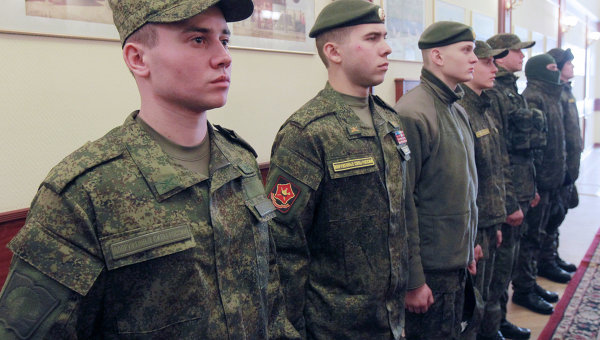
Moscow’s Contract Soldier Plans: Perpetual Dreams
Publication: Eurasia Daily Monitor Volume: 10 Issue: 150
By:

In the aftermath of the military exercise in the Russian Far East on July 13, aimed at testing combat readiness and combat service support, Defense Minister Army-General Sergei Shoigu told President Vladimir Putin that the figure for the future numbers of contract soldiers (kontraktniki) must be revised; 425,000 kontraktniki by 2017 may be insufficient. Shoigu based this rather startling comment, as if a discovery of some magnitude, on the results of the exercise in East Military District (MD). Yet, the precise meaning of Shoigu’s remarks to Putin must be understood in context, along with the underlying planning fiasco that this implies—the roots of which run far deeper than the defense ministry leadership appears to appreciate (https://kremlin.ru/news/18873).
In terms of planning capacity within the Russian Ministry of Defense, the issue of the future of military manpower is a very important yet thorny issue that has bedeviled the work of previous defense ministers. After years of indecision, with proponents of the merits of conscription frequently at loggerheads with those advocating a transition to an all-volunteer system of military manpower, an opportunity appeared after the reform of the Armed Forces began in the fall of 2008. The constant defense planning zigzagging since then was more recently addressed by announcing plans in the spring of 2011 to increase the numbers of contract personnel to 425,000 by 2017 (https://www.ng.ru/nvo/2011-01-12/1_army.html). It seemed to embody a fixed policy, with frequent statements from senior officials, including Shoigu, about the need to recruit 50,000 kontraktniki annually as part of an unstoppable march toward full implementation of these target figures.
As recently as early July 2013, the defense ministry published on its website a plan of activities to 2020, which, among many other aims and targets, reasserted the figure of 425,000 contract personnel serving in the Armed Forces within four years. Nevertheless, within only a short time and apparently rooted in the “lessons learned” from the exercise in East MD, the defense minister admitted that the figure could still be revised. Shoigu may be implying the need to increase the target figure, though more importantly he stated that by the end of the year the defense ministry must produce a “complete list of positions where contract personnel will serve exclusively,” driven by the introduction of “sophisticated systems” in the military each year, which exposes the inadequacies of twelve-month serving conscripts. Shoigu confirmed three important issues: 1) conscription will not be abandoned, 2) the precise posts and roles to be filled by kontraktniki still require sorting out, and 3) the plans and targets remain fluid (https://kremlin.ru/news/18873).
Discovering the potential for fluid plans on military manpower demands understanding its context, as well as the factors that may serve to blunt the high ambitions involved. The promises to greatly increase the numbers of contract soldiers in the Russian Armed Forces are by no means new; in the 1990s, Boris Yeltsin publicly toyed with the idea of transitioning to a fully professional force structure, albeit this transpired to be an election ploy. Since his first term as president, Vladimir Putin signaled that increasing the professional soldier–to–conscript ratio in the military was a priority. In the spring of 2010, the defense ministry and the General Staff admitted that these aspirations had spectacularly failed, while eschewing any sense of blame that might be apportioned to Putin. The open secret in reforming the Armed Forces in 2008–2012 was that the reform lacked any clear plan on the future of military manpower; and by 2011, new target figures were presented as the means to address this weakness. In May 2012, President Putin signed an ukaz (executive edict) to enshrine the goal of 425,000 kontraktniki by 2017 as official state policy, while adding that this meant recruiting 50,000 contract personnel annually in order to reach the target figure (https://graph.document.kremlin.ru/page.aspx?1610877). By April 2013, senior defense officials were reiterating these figures, but Shoigu had “noticed” that “60,000” recruits were needed in 2013 to cover the departure of 10,000 kontraktniki unwilling to renew their contracts (https://nvo.ng.ru/forces/2013-04-12/1_quality.html; https://function.mil.ru/news_page/country/more.htm?id=11709225@egNews).
The latest twist in this long-running planning saga was recently elaborated by Alexei Nikolskiy in Vedomosti. According to Nikolskiy, Defense Minister Shoigu told journalists that the defense ministry has “no clear basis” for the figure of 425,000 kontraktniki. He evidently referred to the planning of this policy. Although Shoigu had not openly called for any increase to the target figure, a former defense ministry official told Vedomosti that this effort to compile a list of posts requiring contract personnel would almost certainly inflate the overall figure. The anonymous former defense ministry official said that the original figures were drawn up on the basis of calculating possible funding by the finance ministry rather than on the actual needs of the Armed Forces (Vedomosti, August 2).
Nikolskiy cited Colonel (retired) Viktor Murakhovskiy as saying that the recounting of posts will prove that the Armed Forces need more than 425,000 kontraktniki. However, this is likely to bring Russia’s Ministry of Defense into conflict with the Ministry of Finance, and Murakhovskiy sees the former losing out to the latter. Indeed, admitting that the finance ministry is unlikely to make available the funds necessary to support boosting kontraktniki numbers beyond 425,000 Murakhovskiy believes this will leave the defense ministry facing an unpleasant choice: reducing the official strength of the Armed Forces or once again accepting the under-manning of its structures (Vedomosti, August 2).
It is important to appreciate that these numbers and targets, either annually or for 2017, remain abstract. It is unclear whether these targets can be achieved, or indeed if the planning capacity exists to fully calculate the actual requirements for the force structure. What is palpably clear is that Shoigu leads a defense ministry with no clearly defined plans on contract personnel, keen to evade the issue of pursuing an all-volunteer force. Yet, it did not take staging an exercise in East MD to “discover” these flaws in the manning system. Meanwhile, it remains unclear how any of these targets may be met, let alone the standards of “planning” that could support the development of the “model” of contract personnel that is so badly needed.




